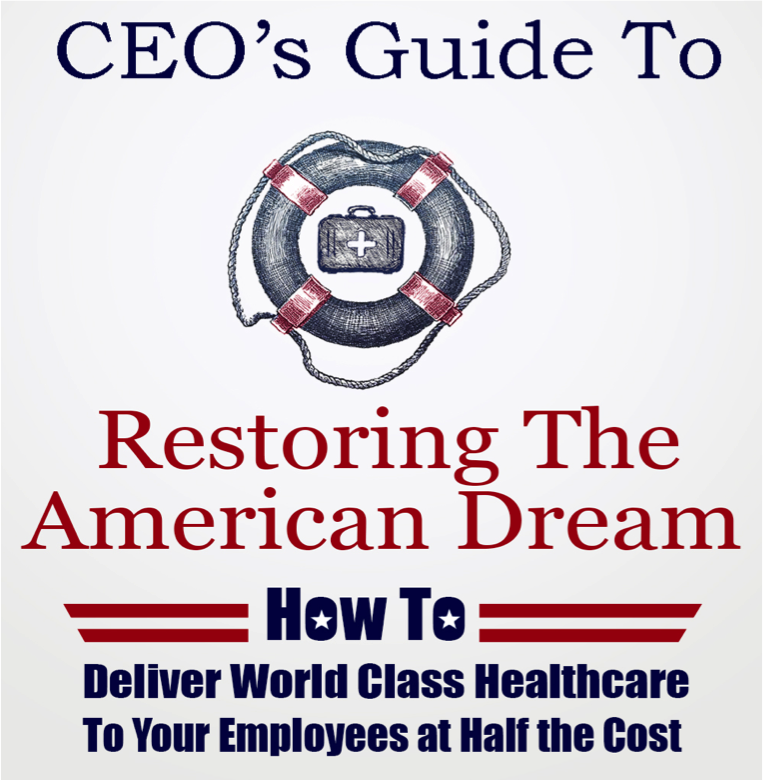I applaud your announcement of a an organization designed to tackle what we believe is the greatest
immediate threat to America -- our status quo healthcare system. I have sent your healthcare leaders the new edition of my book,
The CEO’s Guide to Restoring the American Dream - How to Deliver World Class Health Care to Your Employees at Half the Cost. This book draws on my decades as an insider in healthcare, first as an Accenture consultant working inside dozens of hospitals, followed by founding Microsoft’s $2 billion-plus healthcare platform business and more recently as a healthtech CEO (WebMD acquired my company). Since my departure from WebMD, my life’s work has been to find real-life, practical solutions to the root causes of our healthcare system’s dysfunction. Through this, I’ve found microcosms of employers everywhere that have already tackled the most challenging problems, restoring for them and their employees the American Dream that healthcare has stolen.
The great news is that every fix to healthcare's structural problems has been invented, proven and modestly scaled. With your large employee base and bully pulpit, you are in a unique position to massively scale these fixes.
The wisest employers have found that the best way to slash healthcare costs is to improve benefits. We’ve found no company that has a better benefits package than Rosen Hotels, which spends 55% less per capita on health benefits than a typical company despite having a challenging workforce. For example, 56% of their employees’ pregnancies are categorized as high risk. I highlighted Rosen in
my TEDx talk. They’ve invested money that otherwise would have been squandered in healthcare to provide free college to their employees, employees’ children and residents of a nearby neighborhood. Crime in that neighborhood plummeted 62%, and high school graduation rates soared from 45% to nearly 100%. The CEO’s Guide provides more details on what Rosen and many other smart employers are doing. For example, Pittsburgh-area schools, with a superior benefits plan, are spending 40% less than typical schools.
See also: 3 Innovation Lessons From Jeff Bezos
There are many options to directly improve your employees’ health benefits while slashing costs. Hundreds of us have contributed to the
Health Rosetta, which provides a blueprint for how to purchase healthcare services wisely. The Health Rosetta’s foundation is a set of guiding principles that leading thinkers ranging from Esther Dyson to Bill Gates have contributed to. If I were in your shoes, I’d start in the following places:
 My book can be found on Amazon or downloaded for free.
My book can be found on Amazon or downloaded for free.
- Send employees to Centers of Excellence for high-cost/complexity procedures: Typically, 6% to 8% of your employees consume 80% of spending in a given year. Large employers such as Lowes, Pepsico and Walmart have found stunning levels of misdiagnosis (25% to 67%) and overtreatment at low-value centers. For example, 40% of planned organ transplants diagnosed at community hospitals were deemed medically unnecessary after a second opinion from a high-value center such as the Mayo Clinic. Starbucks and Virginia Mason found that 90% of spinal procedures didn’t help at all and that the problems would have been better addressed via physical therapy. A large tire maker put in a proper musculoskeletal program for their employees and has already created nearly 2% of positive EBITA impact. One of the foremost experts in employer benefits, Brian Klepper, estimates that 2% of the entire U.S. economy is tied up in non-evidence-based, non-value-adding musculoskeletal procedures. [See Chapter 12 for more.]
- Lead the employer movement to avoid opioid overuse: Every addict needs an enabler. Having deeply studied the underlying drivers of the opioid crisis, I found that employers are the key (unwitting) enabler of the opioid crisis on 11 of the 12 major drivers. The overwhelming majority of those with opioid overuse disorders followed doctors orders, and their drugs were paid for by employers. Unlike other great public health crises, the opioid crisis can’t be solved without significant employer action. You can save money and keep your employees and dependents out of harm’s way by adopting a smart benefits approach. [See Chapter 20 for more.]
- Root out widespread criminal fraud: The Economist has called healthcare fraud the $272 billion swindle. More than 150 million health records have been hacked and are available for sale on the dark web. At a meeting with former HHS Secretary Tommy Thompson, I heard the stunning levels of fraud. One Fortune 250 company had more than 500,000 claims that were fraudulent (e.g., claims run 25 times and multiple claims for once-in-a-lifetime procedures such as a hysterectomy). In that room, one of the risk management practice leaders from a Big Four firm called the related ERISA fiduciary risk the largest undisclosed risk he’d seen in his career. The industry hasn’t adopted modern payment integrity software/algorithms for this readily fixable problem. [See Chapter 7 and 19 for more.]
- Ensure employees receive the highest-value drugs: Employers such as Caterpillar have taken matters into their own hands as the pharmaceutical supply chain has become rife with hard-to-follow rebates and other tactics designed to redistribute your profits to them. Caterpillar hasn’t seen healthcare spending increases in 10 years, primarily due to getting their pharmaceutical spending under control. [See Chapter 18 for more.]
- Establish value-based primary care foundation: As IBM found in a worldwide analysis of their $2 billion healthcare spending, it’s not possible to have a high-performance healthcare system without a proper primary care system in place. More than 90% of what people enter the healthcare system for can be addressed in a high-performance primary care setting (rare in the U.S.). Sadly, most U.S. primary care is like milk in the back of the store to get you to other high-margin and often low-value services. Not only can proper primary care go upstream to address issues before they flare up, it can help their patients navigate complex medical conditions. In fact, Amazon just hired Dr. Marty Levine, who was my parents' doctor in a great Medicare Advantage program. Levine and his team have been invaluable in helping us navigate my father’s Parkinson's journey. Based on what has transpired, I am certain that Levine’s team has saved taxpayers more than $200,000 in likely medical bills. This kind of care is not only outstanding, it more than pays for itself. [See Chapter 14 for more.]
See also: The Key to Digital Innovation Success
The title of my TEDx talk was
Healthcare Stole the American Dream - Here’s How We Take it Back. It’s great to see your leadership on this critical issue. The Health Rosetta community stands ready to help your efforts.
Sincerely,
Dave Chase
P.S. We would also encourage you to adopt the Health Rosetta Plan Sponsor Bill of Rights (
https://healthrosetta.org/plan-sponsor-bill-of-rights/). In light of your respective backgrounds in financial services, you are likely to be shocked by the lack of disclosure and conflicts of interest that are standard operating procedure in the vast majority of employer health plans. [See Appendix B for more.]
 My book can be found on Amazon or downloaded for free.
My book can be found on Amazon or downloaded for free.








